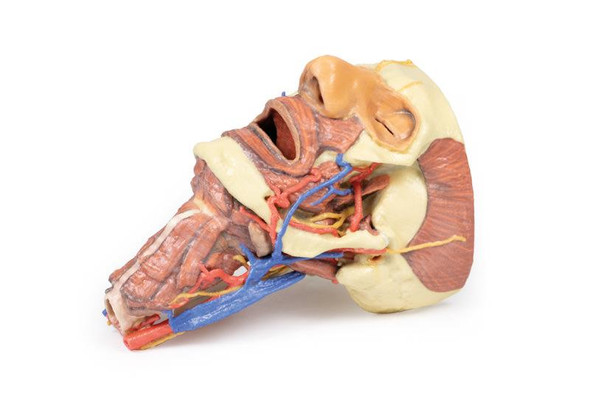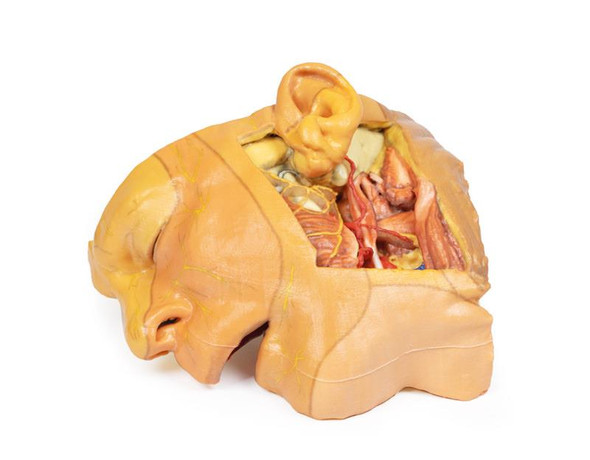Description
At the forefront of medicine and technology, we are proud to offer these incredible, uncompromised replicas of human anatomy. Using the latest 3D printing technology and materials available, this model is an exact replica of a human cadaver, brought to ""life"" by extensive medical scanning and manufacturing technologies. Over are the days of using ethically questionable cadavers, the mess of hazardous preservation chemicals, and the inaccuracies of plastinated models that often over-enhance anatomy for display, not realism. See the future, and the beauty, of real human anatomy with these incredible anatomical replicas!
This large, multipart 3D printed specimen displays a great deal of anatomy spanning the head, neck, thorax, axillae and upper limbs.
Head and neck: The head and neck of the specimen provides views of both superficial and deep structures in the region. The calotte has been removed ~2cm superior to the orbits to expose the brain in relation to the endocranial cavity. The transverse section through the cerebrum demonstrates the relation of the grey matter cortex to the white matter medulla, as well as the lateral ventricles with a small amount of choroid plexus visible in the base of both spaces. The skin and superficial fascia on the right side has been retained and false-coloured to display the angiosomes of the face and posterior neck. On the left side, the superficial tissues have been dissected to expose the muscles of facial expression, muscles of mastication, and deeper structures of the infratemporal fossa including the lingual nerve, terminal branches of the external carotid artery into the superficial temporal and maxillary arteries.
The carotid sheath has been opened on both sides of the neck, and the internal jugular veins and sternocleidomastoid muscles largely removed, to expose the pathway of the common carotid arteries, internal and external carotid arteries, and the vagus nerves. On the right side, the great auricular nerve ascends towards the face, while the hypoglossal nerve can be seen adjacent to the exposed stylohyoid ligament and supra- and infrahyoid muscles. A large thyroid gland is present bilaterally inferior to the thyroid cartilage, with a well-preserved superior thyroid artery and inferior thyroid vein on the right side and across the midline.
The root of the neck - axillary junction: The clavicle has been partially removed on the left side of the specimen (medial to the origin of the deltoid) to expose the first rib and the insertion of anterior scalene muscle. The roots of the brachial plexus (C5-T1) can be seen forming the trunks posterior to this muscle but anterior to middle and posterior scalene muscles they emerge from the interscalene plane. While the subclavian vein has been removed, the subclavian artery is also seen passing behind the scalenus anterior. The transition of the subclavian artery to the axillary artery is exposed, as is its position relative to the cords of the brachial plexus (medial, lateral and posterior).
The left axilla has been dissected to expose the divisions and cords of the brachial plexus and its major and minor branches. The contributions from the medial and lateral cords coming together around the axillary artery to form the median nerve is very distinctive. The course of the medial cord, the ulnar nerve, is clearly visible as is the musculocutaneous nerve as the continuation of the lateral cord. The axillary nerve is seen wrapping posteriorly around the surgical neck of the humerus. The thoracodorsal nerve and artery are seen descending on the medial wall of the axilla to enter the latissimus dorsi muscle. The long thoracic nerve is seen just anterior to this upon the serratus anterior muscle which it supplies.
The axilla/root of neck junction on the right is similar except the clavicle (and subclavius muscle) has been retained, which gives an appreciation of the dimensions of the cervico-axillary canal through which structures gain entry to the axilla. Also on the right side the pectoralis minor and major (that comprise the anterior axillary wall) have been reflected with only a small portion of their insertions being retained.
Thorax: The thorax has been opened via a 'window' on the left to display the internal thoracic wall and mediastinum. The left lung has been removed and the intercostal spaces are discernable deep to the parietal pleura although intercostal neurovascular bundles are only discernable posteriorly. The pericardium has been removed to expose the heart with its apex pointing inferiorly, anteriorly, and to the left. The left side of the heart is exposed as are the left pulmonary veins and arteries (above left main bronchus), ascending aorta, aortic arch and commencement of the descending thoracic aorta. The left vagus nerve and left recurrent laryngeal nerve are easily identified. The right half of the anterior and lateral thoracic wall are intact and display the muscles of the intercostal spaces and inserting hypaxial muscles from the right upper limb. If the specimen is viewed from below, the right lung and pleural spaces along with the diaphragmatic surface of the heart are all evident. While the skin and superficial fascia posterior thorax has been left intact, the distribution of cutaneous branches of dorsal rami have been illustrated along the left side of the specimen.
This magnificent print measures about 20x8x17 inches. From shoulder to shoulder, it is 16.5 inches across. There is a 6 inch tall opening in the left side of the chest. The circumference of the neck is about 14 inches. From the chin to the top of the head, it is 6.5 inches. The circumference of the head is 22 inches. From the left shoulder to the bottom of the left arm, it is 10 inches. From the right shoulder to the bottom of the right arm, it is 7 inches. The circumference of one arm is 9 inches.
Please Note: thanks to the flexibility of manufacturing that 3D Printing offers, this model is ""printed to order"", and is not typically available for immediate shipment. Most models are printed within 15 working days and arrive within 3-5 weeks of ordering, and once an order is submitted to us, it cannot be canceled or altered. Please contact us if you have specific a specific delivery date requirement, and we will do our best to deliver the model by your target date.
Advantages of 3D Printed Anatomical Models
- 3D printed anatomical models are the most anatomically accurate examples of human anatomy because they are based on real human specimens.
- Avoid the ethical complications and complex handling, storage, and documentation requirements with 3D printed models when compared to human cadaveric specimens.
- 3D printed anatomy models are far less expensive than real human cadaveric specimens.
- Reproducibility and consistency allow for standardization of education and faster availability of models when you need them.
- Customization options are available for specific applications or educational needs. Enlargement, highlighting of specific anatomical structures, cutaway views, and more are just some of the customizations available.
Disadvantages of Human Cadavers
- Access to cadavers can be problematic and ethical complications are hard to avoid. Many countries cannot access cadavers for cultural and religious reasons.
- Human cadavers are costly to procure and require expensive storage facilities and dedicated staff to maintain them. Maintenance of the facility alone is costly.
- The cost to develop a cadaver lab or plastination technique is extremely high. Those funds could purchase hundreds of easy to handle, realistic 3D printed anatomical replicas.
- Wet specimens cannot be used in uncertified labs. Certification is expensive and time-consuming.
- Exposure to preservation fluids and chemicals is known to cause long-term health problems for lab workers and students. 3D printed anatomical replicas are safe to handle without any special equipment.
- Lack of reuse and reproducibility. If a dissection mistake is made, a new specimen has to be used and students have to start all over again.
Disadvantages of Plastinated Specimens
- Like real human cadaveric specimens, plastinated models are extremely expensive.
- Plastinated specimens still require real human samples and pose the same ethical issues as real human cadavers.
- The plastination process is extensive and takes months or longer to complete. 3D printed human anatomical models are available in a fraction of the time.
- Plastinated models, like human cadavers, are one of a kind and can only showcase one presentation of human anatomy.
Advanced 3D Printing Techniques for Superior Results
- Vibrant color offering with 10 million colors
- UV-curable inkjet printing
- High quality 3D printing that can create products that are delicate, extremely precise, and incredibly realistic
- To improve durability of fragile, thin, and delicate arteries, veins or vessels, a clear support material is printed in key areas. This makes the models robust so they can be handled by students easily.






























